| Oracle® CEP IDE Developer's Guide for Eclipse Release 11gR1 (11.1.1) Part Number E14301-02 |
|
|
View PDF |
| Oracle® CEP IDE Developer's Guide for Eclipse Release 11gR1 (11.1.1) Part Number E14301-02 |
|
|
View PDF |
Oracle CEP IDE for Eclipse is an IDE targeted specifically to programmers that want to develop Oracle CEP applications.
This chapter describes:
Section 2.2, "Installing the Latest Oracle CEP IDE for Eclipse"
Section 2.3, "Installing the Oracle CEP IDE for Eclipse Distributed With Oracle CEP"
Oracle CEP IDE for Eclipse is a set of plugins for the Eclipse IDE designed to help develop, deploy, and debug applications for Oracle CEP.
The key features of the Oracle CEP IDE for Eclipse are as follows:
Project creation wizards and templates to quickly get started building event driven applications.
Advanced editors for source files including Java and XML files common to Oracle CEP applications.
Integrated server management to seamlessly start, stop, and deploy to Oracle CEP server instances all from within the IDE.
Integrated debugging.
Event Processing Network (EPN) visual design views for orienting and navigating in event processing applications and visually creating and editing EPN components.
Oracle CEP application source file validation including Oracle Continuous Query Language (Oracle CQL) syntax highlighting and component configuration and assembly files.
Ability to build and export deployable Oracle CEP applications.
Integrated support for the Oracle CEP Visualizer so you can use the Oracle CEP Visualizer from within the IDE.
In Release 11gR1 (11.1.1), Oracle CEP IDE for Eclipse requires JDK 6.0. For more information, see:
"Setting Your Development Environment" in the Oracle CEP Getting Started
For more information about Oracle CEP IDE for Eclipse, see http://www.oracle.com/technology/products/event-driven-architecture/cep-ide/11/.
New versions of the IDE will be made available via the Oracle Technology Network Web site. Oracle recommends that you install the IDE from this Eclipse update site.
To install the latest Oracle CEP IDE for Eclipse:
Obtain the required versions of Eclipse (3.3.2) and WTP (2.0). We recommend you take the entire Europa installation available at the following Web sites:
Note:
Check the Oracle CEP Web site (http://www.oracle.com/technologies/soa/complex-event-processing.html) for the latest requirements on the Eclipse tools.Open your Eclipse IDE and select the menu item Help > Software Updates > Find and Install.
The Install/Update dialog appears as Figure 2-1 shows.
Select the Search for New Features option.
Click Next.
The Update Sites to Visit dialog appears as Figure 2-2 shows.
Click New Remote Site.
The New Update Site dialog appears as Figure 2-3 shows.
Configure this dialog as Table 2-1 describes.
Click OK.
Complete the Update Manager, selecting to install the Oracle CEP tools.
When prompted restart, Eclipse. If you skip this, unreliable behavior can occur.
To confirm the installation, select Help > About Eclipse Platform.
The About Eclipse Platform dialog appears as Figure 2-4 shows.
Click Plug-In Details.
The About Eclipse Platform Plug-ins dialog appears as Figure 2-5 shows.
Figure 2-5 About Eclipse Platform Plug-ins Dialog
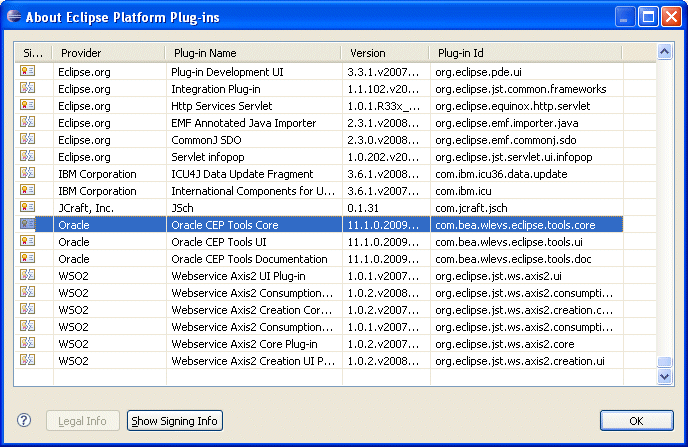
Scroll down in the list and confirm that the plug-ins that Table 2-2 lists are shown.
After installing Oracle CEP IDE for Eclipse, consider the following configuration topics:
A version of the Oracle CEP IDE for Eclipse is shipped with the Oracle CEP product, although this version might be older than the one on the Oracle Technology Network site.
To install the Oracle CEP IDE for Eclipse distributed with Oracle CEP:
Obtain the required versions of Eclipse (3.3.2) and WTP (2.0). We recommend you take the entire Europa installation available at the following Web sites:
Open your Eclipse IDE and select the menu item Help > Software Updates > Find and Install.
The Install/Update dialog appears as Figure 2-1 shows.
Select the Search for New Features option.
Click Next.
The Update Sites to Visit dialog appears as Figure 2-2 shows.
Click New Archived Site.
The Select Local Site Archive dialog appears as Figure 2-8 shows.
Figure 2-8 Select Local Site Archive Dialog
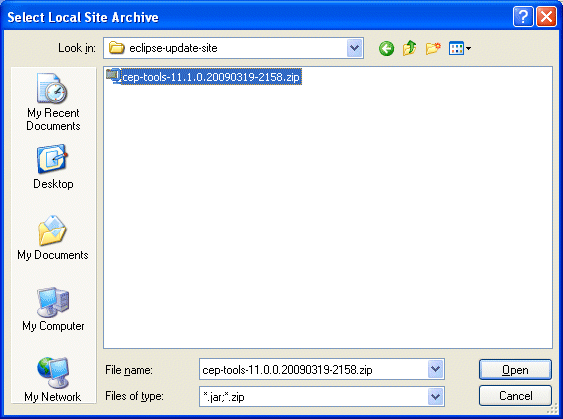
Navigate to the ORACLE_CEP_HOME/ocep_11.1/eclipse-update-site directory and select the cep-tools-11.1.0.DATE-BUILD.zip file.
Where ORACLE_CEP_HOME refers to the main directory into which you installed Oracle CEP, such as /oracle_cep, and DATE is the build date and BUILD is the build number.
Click Open.
Complete the Update Manager, selecting to install the Oracle CEP tools.
When prompted restart, Eclipse. If you skip this, unreliable behavior can occur.
To confirm the installation, select Help > About Eclipse Platform.
The About Eclipse Platform dialog appears as Figure 2-4 shows.
Click Plug-In Details.
The About Eclipse Platform Plug-ins dialog appears as Figure 2-5 shows.
Figure 2-10 About Eclipse Platform Plug-ins Dialog

Scroll down in the list and confirm that the plug-ins that Table 2-2 lists are shown.
After installing Oracle CEP IDE for Eclipse, consider the following configuration topics:
This section describes how to configure Eclipse to work with the Oracle CEP.
To configure Eclipse:
Exit out of Eclipse if it is running.
Install a Java 6 JRE on your computer.
The JRockit Java 6.0 JRE is installed with Oracle CEP in your Oracle CEP home directory. For example:
C:\OracleCEP\jrockit-R27.6.0-50-1.6.0_05\jre
Using the editor of your choice, open your eclipse.ini file located in your Eclipse install directory, for example, C:\eclipse as Example 2-1 shows.
Note:
When making changes to theeclipse.ini file, add arguments one argument per line, as http://wiki.eclipse.org/Eclipse.ini describes.
For more information about configuring Eclipse, see http://wiki.eclipse.org/FAQ_How_do_I_run_Eclipse.
Add the following lines to the eclipse.ini file as Example 2-2 shows.
Add the following to the eclipse.ini file as Example 2-3 shows.
Where PATH-TO-JRE-6.0-JAVAW is the fully qualified path to your Java 6.0 JRE javaw executable. For example:
-vm C:\OracleCEP\jrockit-R27.6.0-50-1.6.0_05\jre\bin\javaw.exe
Note:
Do not put both the-vm and the path on the same line. Each must be on a separate line as Example 2-3 shows.Save and close the eclipse.ini file.
Start Eclipse.
Select Help > About Eclipse Platform and click Configuration Details.
The Configuration Details dialog appears as shown in Figure 2-11.
Figure 2-11 Configuration Details for Java 6
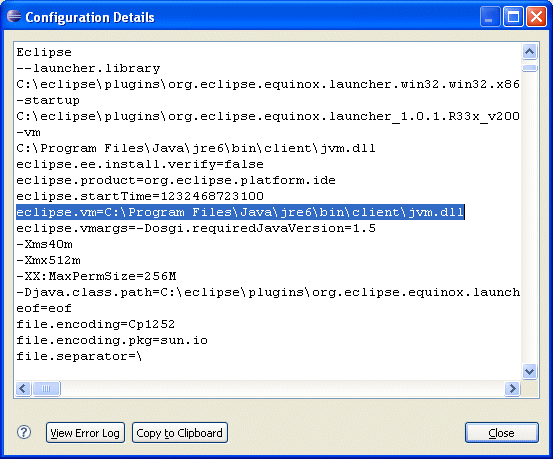
Confirm that the eclipse.vm property points to the Java 6.0 JRE you configured in the eclipse.ini file.
Open the Oracle CEP project you originally created using Java 5.
Select Window > Preferences.
The Preferences dialog appears as shown in Figure 2-12.
Expand the Server option and select Installed Runtimes.
Select a runtime that uses the Java 6 JRE.
Click OK.
Right-click your project and select Properties.
The Project Properties dialog appears as shown in Figure 2-13.
Figure 2-13 Project Properties Dialog: Java Build Path
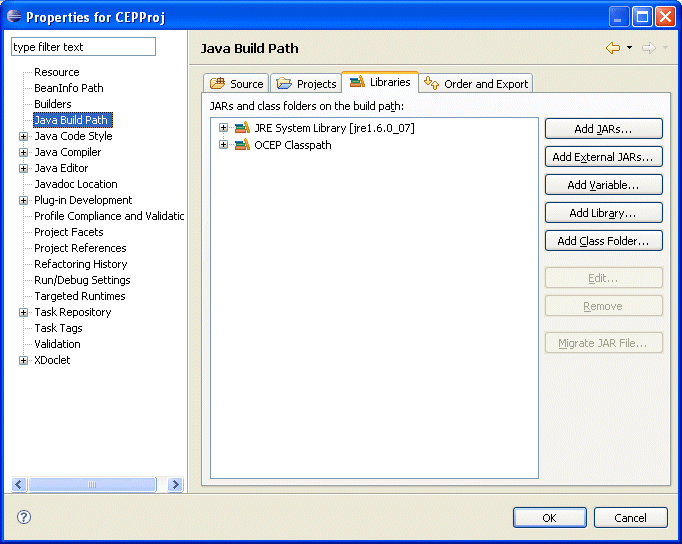
Select the Java Build Path option and click on the Libraries tab.
Select the existing JRE System Library [jre1.5.0_XX] Java 5.0 library and click Remove.
Create a new JRE System Library for Java 6.0 by clicking Add Library and choosing the Java 6.0 JRE.
Select the Project Facets option.
The Project Facet properties are displayed as Figure 2-14 shows.
Figure 2-14 Project Properties Dialog: Project Facets
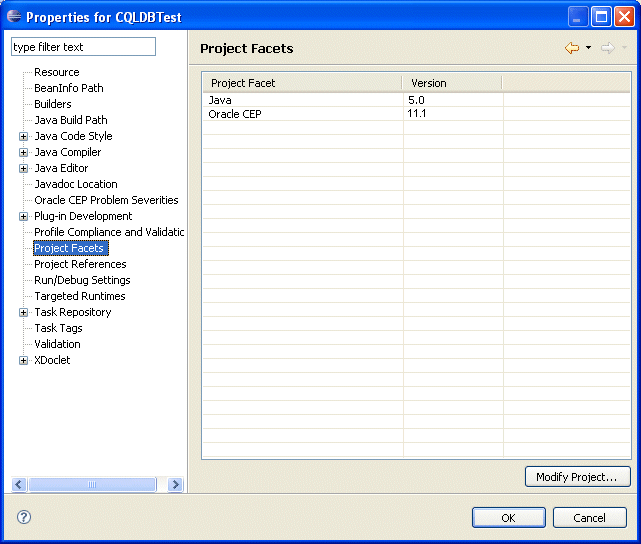
Click Modify Project.
The Modify Faceted Project dialog appears shown in Figure 2-15.
For the Java facet, select 6.0 from the Version pull-down menu.
Click Finish.
Click OK.
Your project will now build and run using Java 6.0.